Q&A – Ask Neil: September 12, 2024
(Please read these instructions carefully.)
Before you post your question, please look at recent issues to see if someone else has already asked it. You might find your answer there.
How to submit your question…
(Note: You may need to allow a pop-up window to come up in order to get the link for sending your photo(s). If you have already submitted your question and didn’t see the pop-up window, please click here.)
• Click the link provided below to post your question. After you submit your question, a new window will pop up giving you the address to which you can e-mail a SHARP, HIGH-RESOLUTION PHOTO to accompany your question. Please DO NOT SEND THUMBNAIL PHOTOS in case I need to zoom in to see things.
• Click here to post your question.
• Please ONLY POST YOUR QUESTION ONE TIME. We can only accept a set number of questions each week, and when we get duplicates it costs other people their chances.
• One question per reader, please.
• Please use this only for posting questions – not for standard emails.
• Watch for your answer in the following week’s e-gardens.
• I choose those of greatest general interest. For example, plant IDs seldom make the cut.
• I must have your first name or initials.
• I must have your city or county. (Texas is a very large state.)
QUESTION 1
PRE-EMERGENT GRANULES APPLIED FRIDAY. SUNDAY THROUGH TUESDAY 12.5 IN. OF HARD RAIN. WHAT IS EFFICACY OF GRANULES NOW?
Question: I applied pre-emergent granules to my lawn last Friday. On Sunday the rain began, and by Tuesday night we had received 12.5 in. of hard rain. Our yard was underwater for at least a day. Where does this leave us as far as efficacy of the granules? Kay S., San Angelo.
Answer: Hats off to you. In 20 years of e-gardens, no one has ever used the word “efficacy” in a question here. I’m quite impressed and I’ll try to reply with the same style and grace.
Sadly, I believe the granules are somewhere down the Concho River. That’s a lotta water. On the other hand, think about how much that would have cost you if it had come out of the tap. If it were my lawn, and if I’d had a problem with winter grassy weeds in recent years, I’d make another application. I rarely suggest that, but 12.5 in. is so much! We were in Abilene that Sunday afternoon and evening and it was starting to rain. I watched the weather the rest of the week, and all of your part of the state got doused. So, there was some good news out of it all.
QUESTION 2
WHAT TYPE OF FROST CLOTH DO YOU USE IN THE WINTER, AND HOW DO YOU FASTEN IT TO THE GROUND?
Question: I have a suggestion for an upcoming story. You talk about using frost cloth in really cold weather. What type do you use, and how do you fasten it to the ground? Louise Y., Grapevine.
Answer: I’ll go ahead and answer it now. I don’t remember the brand I have. I bought it at a local retail nursery in Dallas 4 or 5 years ago and I’ve re-used it each winter cold spell since. I bought a roll that is 8 ft. wide and I believe 50 ft. long. We have pre-cut it to fit each of the beds and it’s rolled up in large heavy-duty plastic trash bags with labels firmly tied on so I don’t mistake it for rubbish.
When a cold spell is about to blow in, we take it out onto the lawn or drive and open the big, loose rolls so we can pull it up and over the shrubs and groundcovers.
My means of securing it to the soil (critical in holding in the warmth of the sun) is a bit crude. I have river rocks in a landscape bed just a few feet away, and we reach over and take as many as we need. When it warms up, I just put them back onto the pile with the other rocks. I don’t believe I’ve ever lost a plant or more than a few leaves when they were covered.
QUESTION 3
WHAT IS HAPPENING TO MY TEXAS REDBUD TREE?
Question: What is happening to my Texas redbud tree? All the leaves look like this, and many have already fallen off. It is watered twice per week. It was planted 8 years ago. I’ve seen the spots before, but not to the point of this leaf drop. Rachael S., Pflugerville.
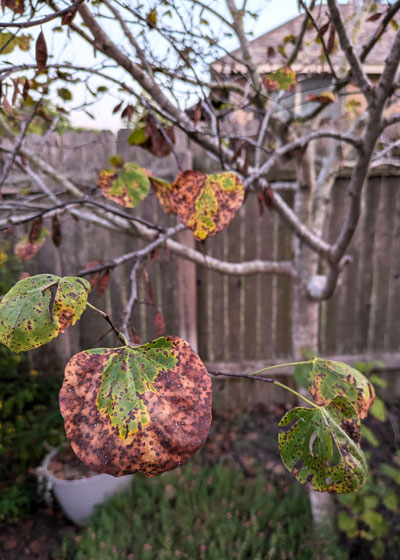
Answer: This is a fungal leaf spot that is quite common on redbuds. As you mentioned, we all see it, but only in very wet seasons will it knock all the leaves off like you’ve been experiencing. Here is a link to the Texas A&M Plant Pathology reference, Texas Plant Disease Handbook. Look at the middle disease.
QUESTION 4
SHOULD I BE CONCERNED ABOUT MY ARIZONA ASH?
Question: My Arizona ash made it through the really cold winter of February 2021 with only some trimming back. I recently noticed near the top of the center branch that sap was oozing out. Do I need to be concerned? Ron L., McKinney.
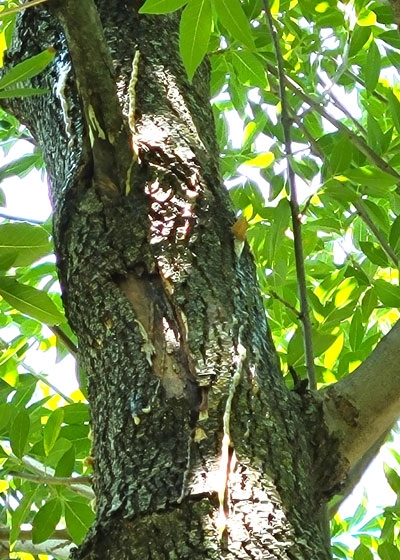
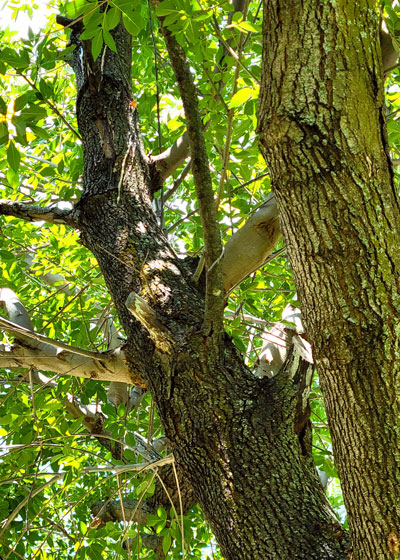
Answer: Unfortunately, with ash trees you always need to be concerned, especially now. More on that in a moment. If you look at either of your photos you’ll see that everywhere that you left stubs when you trimmed and removed an old branch the tree has failed to heal properly. Decay has set in and it has moved down into the branch from that point of trimming. It’s imperative, whenever you trim, that you leave no stubs. You want to leave a very small section of the branch collar (where the branch swells and broadens as it attaches). But on branches the size of those you were removing the branch section won’t be more than 1/4- to 1/2-in. There is so much decay within the trunk and branches that it’s going to be difficult to save the tree. You can see that decay where the bark is splitting and falling away.
All of this may be moot. Ashes in our state are about to be attacked by the Emerald Ash Borer. This beetle has devastated ash forests all through the Midwest, and in the past several years they have moved into East Texas. They have been found in Denton, Dallas, and surrounding counties. It’s just a matter of time. Unfortunately, we do not have a preventive or cure for them.
I’m sorry for all the bad news, but I’ve always made it my policy to be honest.
QUESTION 5
WHY ARE THE OLDER LEAVES OF MY LIVE OAK DISCOLORED?
Question: What’s going on with my live oak tree? All the new growth is “normal” green, but all the other leaves are a more olive, muted green. What would cause that? Jessica J., Oak Point, Denton County.
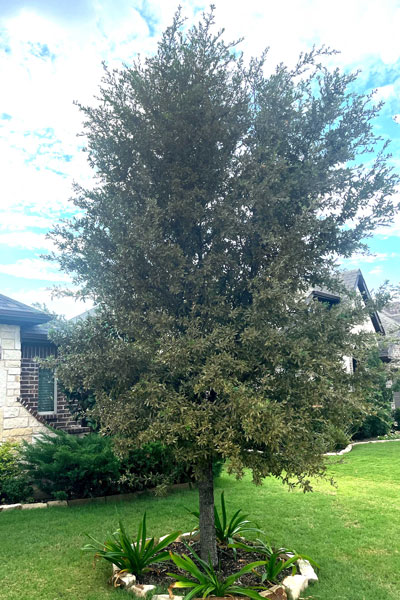
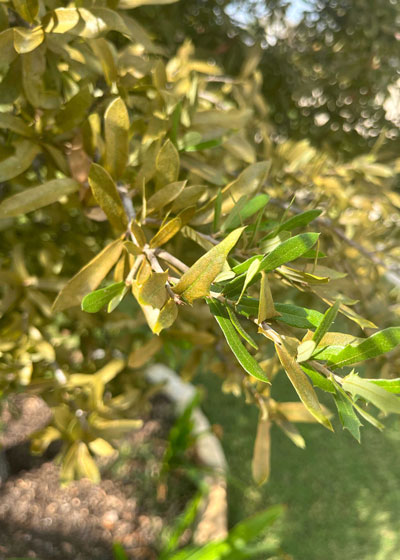
Answer: Since the tree is established (not newly planted), I’m going to guess that there has been some type of sucking insect that has visited it earlier this growing season.
This is fairly common on bur oaks, Chinquapin oaks, cedar elms, azaleas, Boston ivy, loropetalums, sycamores, pyracanthas, cotoneasters, and a host of other landscape trees and shrubs. In those cases, a small insect with clear wings called a lace bug sucks fluids out of the backs of the leaves. In serious outbreaks you’ll get hundreds of lace bugs and the leaves will turn the color of old newspaper or file folders. But they don’t do major harm to the plants.
Lace bugs will leave black specks (their excrement) on the backs of the leaves. Those specks will be easily seen even if the insects themselves are much more difficult to find. They might still be there if lace bugs were involved.
In any event, since the new growth is healthy, the problem, whatever the source, seems to be gone. No further call to action.
QUESTION 6
HOW DO I KILL THIS VINE?
Question: How do I kill this vine? It entwines itself through my rose bushes, also around other shrubs. I’ve put down mulch, but it still pops up. Round Up will kill one plant, but another just pops up somewhere else. How do I get rid of it? Marilyn H, Saginaw, Tarrant County.
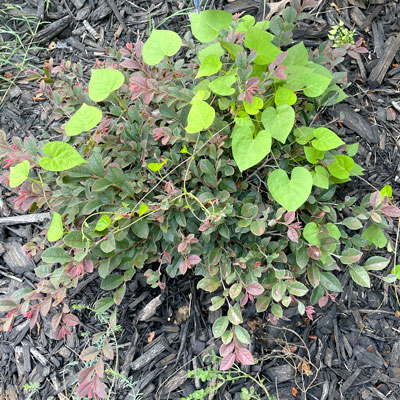
Answer: This is another of the wild morning glories. Some are annuals and others are perennials. The only way I’ve ever been successful in eliminating them is to cut them off at the ground, then cover them with weed-blocking fabric. I overlap the fabric by 3-4 inches at seams to take away any chance they might have of coming up through the gaps. That way, the only place I have to worry about is right around the necks of the plants. Weedkillers won’t kill morning glories successfully. After a year or two of having the roll mulch in place I can remove it and put bark mulch back in place. That’s usually all I have to do. You should also do that for that bermudagrass I see coming up in the bed.
QUESTION 7
DO I NEED TO TREAT FOR ARMYWORMS IN ST. AUGUSTINE?
Question: We have been contacted by a company wanting to treat our yard for armyworms. Our yard is St. Augustine. It’s my understanding that the worms prefer bermudagrass. Any advice?
Answer: That was just a generic mailer or phone drive. Armyworms will leave your St. Augustine alone. If your neighbors have bermudagrass, watch their lawns for signs of rapid browning and loss of leaf blades on the grass. The armyworms are easy to see, plus you’ll often see flocks of birds feeding happily on them as well. The recent rains may cause a spike in their numbers, but you personally shouldn’t have any trouble. We will probably be hearing about them if a surge crops up. Farmers also will let us know.
